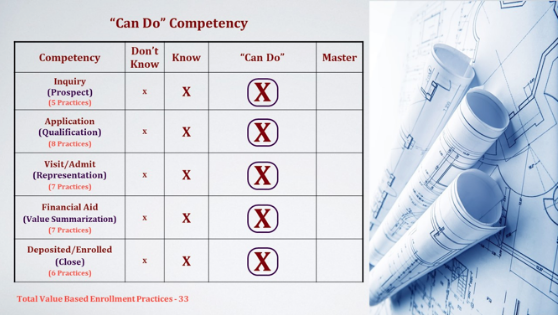5 Necessary Ingredients of a Strong Enrollment Team
A strong enrollment team is supportive of one another and believes in the institution’s mission and vision. They do not settle for a mediocre message and they have an “extra mile” work ethic. They exist in a culture where “failure” is not feared, rather, it is used as a tool to redirect efforts and resources. Sound like your team? If not, it can be. Based on our experience working with successful enrollment teams across the country, here’s what we see working over and over again.
1. Strong enrollment teams make everything about value(s).Start by defining your values, as the leader. Then get your team to do the same—What motivates them? Developing and understanding this will help with the dynamics of working together as a team. Celebrate these often. Post them everywhere.
Then, work with marketing to define the school values (not necessarily the ones that are on the school seal) from the student’s perspective. We often find that what the marketing team messages as the school values and what admissions think are the school values are not always the same. All the more reason to bring marketing and admissions under one umbrella with one leader who has a cohesive vision for the team. Then develop messaging around those values. Practice communicating these values verbally and in any other way possible.
Here is an example of value identified, value defined, value promoted: When George Fox University took a deeper dive into their student population's demographics they discovered that an overwhelming concentration of their primary market came from the Northwest. In particular, within a radius immediate to their campus in the Portland region. This moved them to redirect their resources (marketing and recruitment budget) into developing messaging around the brand concept of “Being Known”. This included campus community ethos, small class sizes and residence halls, local community and connections, etc. They also offered local students an exclusive scholarship. This messaging (and savings) appealed to both parents and students in the state of Oregon and virtually doubled their average new student enrollment rate per admissions counselor.
Point to ponder: I like to challenge teams with, “Value must be believed in for it to be effective.” Our teams must be able, and empowered, to truly believe in the value(s) of our institutions. This includes all the things we value, even those that we are not doing as well as we hope to. It means uncovering strengths that will speak to our prospective families' needs and wants. If our teams do not genuinely believe, it will be conveyed at some point in the relationship, and that will sabotage the chances to win that family over.
2. Strong enrollment teams educate, educate, educate.
You may have heard about the conversation when a CFO asks their CEO,“What happens if we invest in developing our people and then they leave us?” The CEO answers, “What happens if we don’t and they stay?” Education and training demonstrate that each team member is valued and valuable.
In our Value Based Enrollment Methodology training, we stand by the assertion that it is not enough for our admissions counselors to just “know it” (acknowledge and accept), but that they must be challenged and empowered to do it - We call this our “Can Do” Competency principle.
The following chart shows our movement expectations for the teams we coach:

We expect the team who goes through our Enrollment Methodologies training and coaching will walk away with a confident “Can Do” competency.
NOTE: The “Master” column is for when we’re occasionally asked what it takes to invest in comprehensively training/coaching a designated team member to master the practices to become the resident trainer going forward.
3. Strong enrollment teams set SMART goals.
Set SMART goals: Specific – Target a specific area for improvement. For example, yield rates and academic profile or internal process enhancements and intracampus communication. Measurable – Quantify or at least suggest an indicator of progress with specific timelines. Assignable – Empower someone to take it on as lead. Realistic – State what results can realistically be achieved, given available resources. Be mindful of the difference between “To Do’s” and actual goals. Goals go beyond “To Do’s” as they have specific expectations attached to them. Trackable – Specify by when the result(s) can/need to/should be achieved. Open-ended goals are ineffective and typically reinforce procrastination.
SMART goal strategies are likely to be most effective when accountability is a priority. A module in our curriculum is titled: Enrollment and Personal Goal Setting. In it, we teach seven Principles and two Disciplines. The Disciplines are: You must be focused and You must be accountable! “Knowledge of goals is not as important as the discipline to accomplish them.”
4. Strong enrollment teams celebrate EVERYTHING!
Celebrate “wins” as well as “dedication” in ways big or small:
- Thank your employees like you thank your volunteers
- Periodic lunch treats and Starbucks runs (as needed!)
- After-hour non-work related activities
- Commitment to staff retreats
- Recognition at All-Personnel Meetings
- Social media mentions
- Make sure everyone else knows what you are celebrating
This leads us to the final point…
5. Strong enrollment team leaders are the team’s advocates.When a president asks the team leader, “Just what is that team doing?” it’s important to be prepared with the answer. Quite frankly, if they are asking the question, it’s too late. A leader’s role is to lead the team to success, promoting their successes is the natural result. Everyone “up the chain” should know what the team is doing and celebrate it as well.
Leaders who advocate for their staff regularly address the need to examine wages, titles, and growth in the team member’s position (internally and externally), and provide professional development opportunities.
The Value of Change: Over my 30+ years serving Higher Education, the one constant has been change. Admissions processes have always been in flux and complicated because these teams assist prospective students. Prospective students and their constituents (those helping the student make a decision) are themselves in the midst of huge changes and inconsistent influences. Most recently, they have been influenced by external forces such as the discreditable internet, the shady impact of social media, and a seeming inability to make autonomous decisions. Add to this the complication of state and federal interference on an unprecedented level.
We must build strong enrollment teams to help prospective students and their constituents navigate this ever-evolving enrollment landscape. The foundation of a strong, synergistic enrollment team is the understanding—and acceptance—of the inevitable change-to-grow-to-change cycle. Diligently applying these essential ingredients will enable leaders to get out in front (and indeed, stay out in front) of the evolution of the college search, planning, and selection process.
-----
Vance Pascua has served Secondary and Higher Education since 1987. A graduate of the University of California at Santa Barbara, he has served up the ranks, from Admissions Counselor to Dean of Admissions & Financial Aid. He’s also spent significant time leading Athletic Recruitment and Retention efforts from the Admissions and Financial Aid side. Currently, he serves colleges and universities by coaching and training enrollment teams with Value Based Inc.'s Enrollment Methodologies to maximize their impact and results. He enjoys musing and writing on topics like team building, innovation, and the college search and planning process. He lives in Roseville, California with his wife, Diane, and their beloved dogs, Buster and Willie.


.png?width=1800&height=600&name=VBI%20Logo%20White%20(4).png)